Leadership Strategies and Management Report for Business Success
VerifiedAdded on 2022/08/25
|8
|1507
|19
Report
AI Summary
This report, titled "Leadership Strategies and Management," delves into the crucial aspects of effective leadership within organizations. It begins by highlighting the significance of leaders in guiding employees towards achieving company goals and emphasizes the importance of different leadership styles. The report then explores key facets of leadership, including maintaining focus on organizational goals, the authenticity of a leader, courage, time management, and empathy. It further examines the relationship between leadership and management, differentiating between the roles of managers and leaders, focusing on their distinct responsibilities and approaches. The report concludes by emphasizing the irreplaceable role of leaders in driving organizational success and the essential skills and capabilities required for effective leadership. References to relevant academic research are also included.
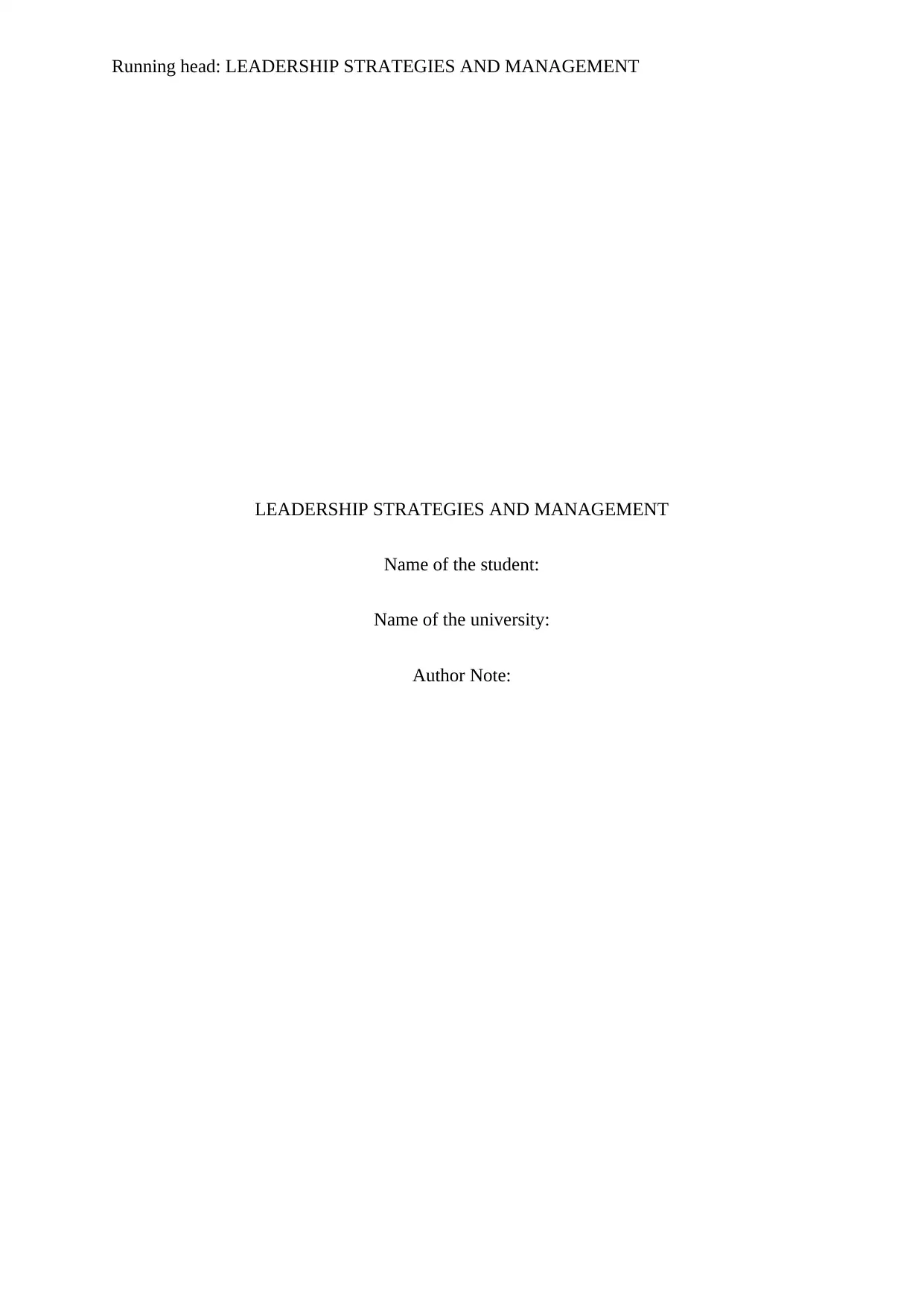
Running head: LEADERSHIP STRATEGIES AND MANAGEMENT
LEADERSHIP STRATEGIES AND MANAGEMENT
Name of the student:
Name of the university:
Author Note:
LEADERSHIP STRATEGIES AND MANAGEMENT
Name of the student:
Name of the university:
Author Note:
Paraphrase This Document
Need a fresh take? Get an instant paraphrase of this document with our AI Paraphraser
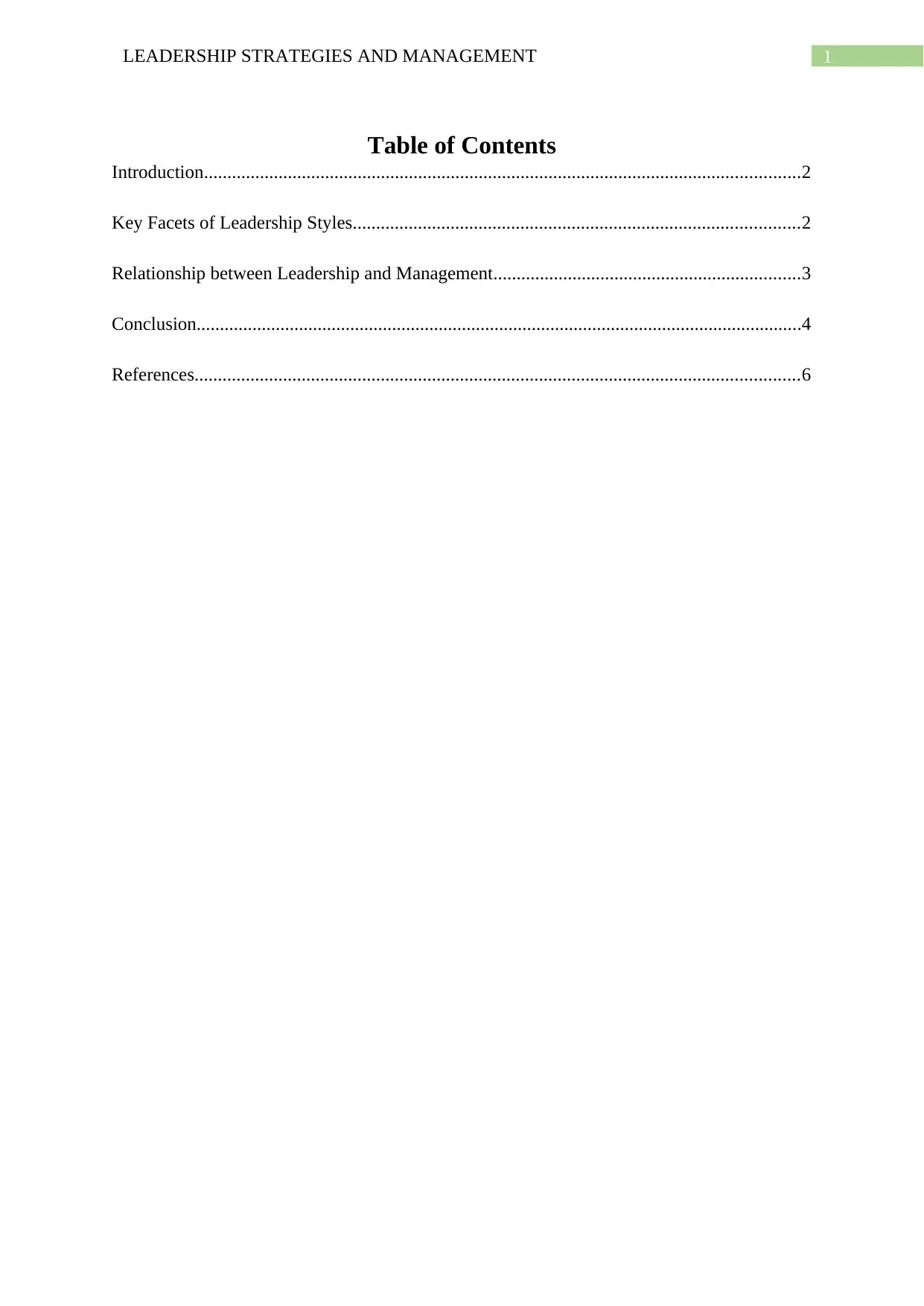
1LEADERSHIP STRATEGIES AND MANAGEMENT
Table of Contents
Introduction................................................................................................................................2
Key Facets of Leadership Styles................................................................................................2
Relationship between Leadership and Management..................................................................3
Conclusion..................................................................................................................................4
References..................................................................................................................................6
Table of Contents
Introduction................................................................................................................................2
Key Facets of Leadership Styles................................................................................................2
Relationship between Leadership and Management..................................................................3
Conclusion..................................................................................................................................4
References..................................................................................................................................6
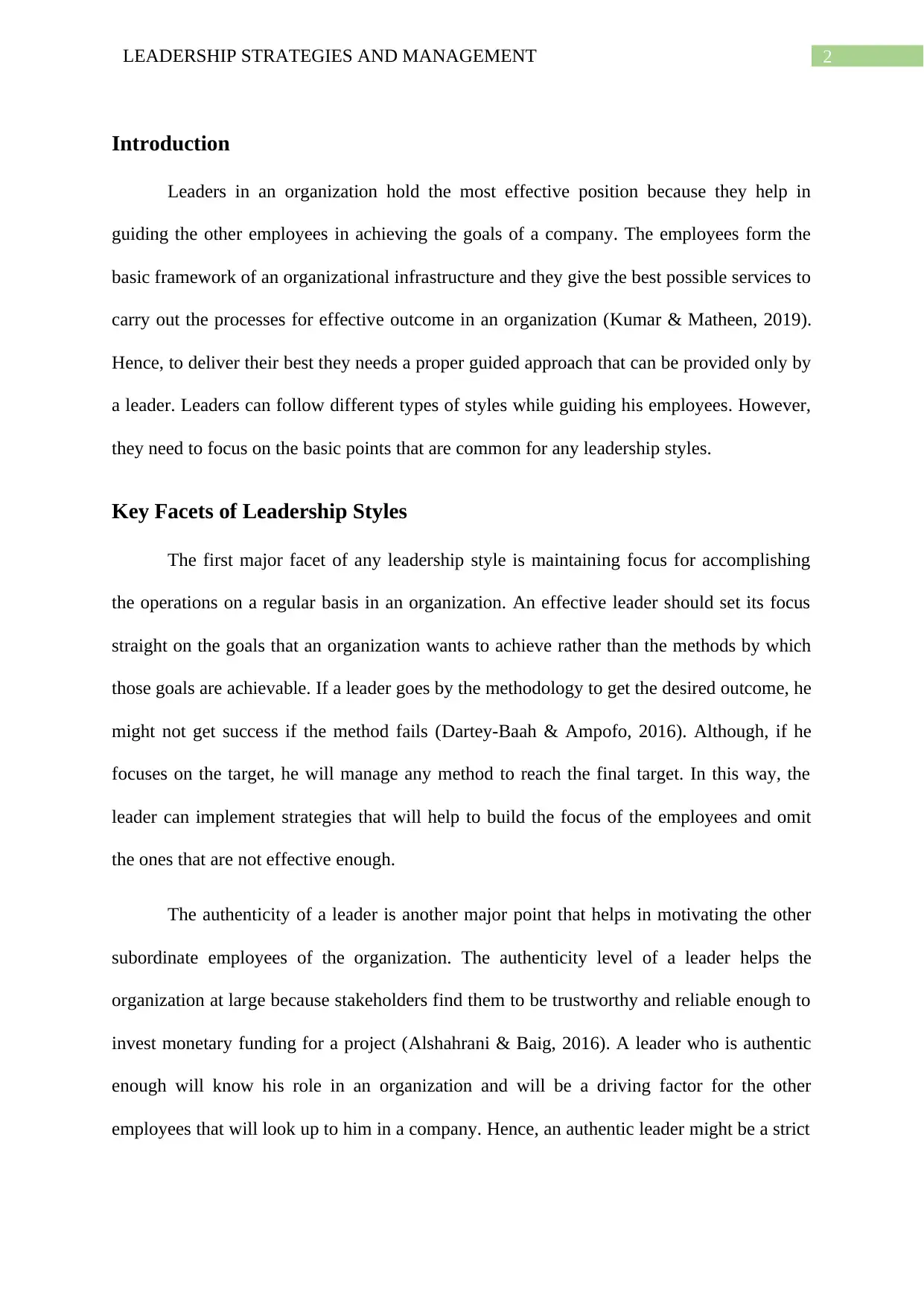
2LEADERSHIP STRATEGIES AND MANAGEMENT
Introduction
Leaders in an organization hold the most effective position because they help in
guiding the other employees in achieving the goals of a company. The employees form the
basic framework of an organizational infrastructure and they give the best possible services to
carry out the processes for effective outcome in an organization (Kumar & Matheen, 2019).
Hence, to deliver their best they needs a proper guided approach that can be provided only by
a leader. Leaders can follow different types of styles while guiding his employees. However,
they need to focus on the basic points that are common for any leadership styles.
Key Facets of Leadership Styles
The first major facet of any leadership style is maintaining focus for accomplishing
the operations on a regular basis in an organization. An effective leader should set its focus
straight on the goals that an organization wants to achieve rather than the methods by which
those goals are achievable. If a leader goes by the methodology to get the desired outcome, he
might not get success if the method fails (Dartey-Baah & Ampofo, 2016). Although, if he
focuses on the target, he will manage any method to reach the final target. In this way, the
leader can implement strategies that will help to build the focus of the employees and omit
the ones that are not effective enough.
The authenticity of a leader is another major point that helps in motivating the other
subordinate employees of the organization. The authenticity level of a leader helps the
organization at large because stakeholders find them to be trustworthy and reliable enough to
invest monetary funding for a project (Alshahrani & Baig, 2016). A leader who is authentic
enough will know his role in an organization and will be a driving factor for the other
employees that will look up to him in a company. Hence, an authentic leader might be a strict
Introduction
Leaders in an organization hold the most effective position because they help in
guiding the other employees in achieving the goals of a company. The employees form the
basic framework of an organizational infrastructure and they give the best possible services to
carry out the processes for effective outcome in an organization (Kumar & Matheen, 2019).
Hence, to deliver their best they needs a proper guided approach that can be provided only by
a leader. Leaders can follow different types of styles while guiding his employees. However,
they need to focus on the basic points that are common for any leadership styles.
Key Facets of Leadership Styles
The first major facet of any leadership style is maintaining focus for accomplishing
the operations on a regular basis in an organization. An effective leader should set its focus
straight on the goals that an organization wants to achieve rather than the methods by which
those goals are achievable. If a leader goes by the methodology to get the desired outcome, he
might not get success if the method fails (Dartey-Baah & Ampofo, 2016). Although, if he
focuses on the target, he will manage any method to reach the final target. In this way, the
leader can implement strategies that will help to build the focus of the employees and omit
the ones that are not effective enough.
The authenticity of a leader is another major point that helps in motivating the other
subordinate employees of the organization. The authenticity level of a leader helps the
organization at large because stakeholders find them to be trustworthy and reliable enough to
invest monetary funding for a project (Alshahrani & Baig, 2016). A leader who is authentic
enough will know his role in an organization and will be a driving factor for the other
employees that will look up to him in a company. Hence, an authentic leader might be a strict
⊘ This is a preview!⊘
Do you want full access?
Subscribe today to unlock all pages.

Trusted by 1+ million students worldwide
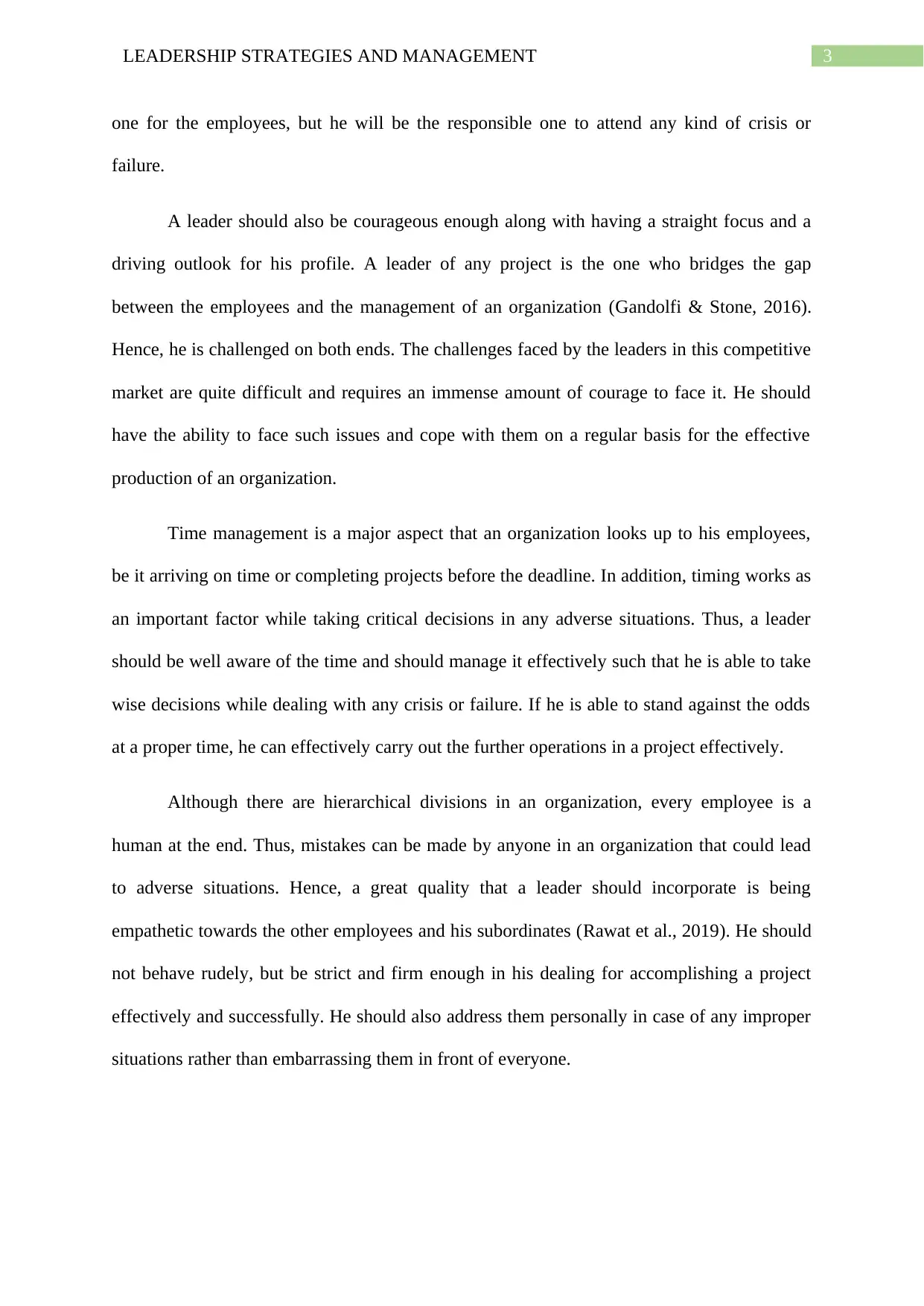
3LEADERSHIP STRATEGIES AND MANAGEMENT
one for the employees, but he will be the responsible one to attend any kind of crisis or
failure.
A leader should also be courageous enough along with having a straight focus and a
driving outlook for his profile. A leader of any project is the one who bridges the gap
between the employees and the management of an organization (Gandolfi & Stone, 2016).
Hence, he is challenged on both ends. The challenges faced by the leaders in this competitive
market are quite difficult and requires an immense amount of courage to face it. He should
have the ability to face such issues and cope with them on a regular basis for the effective
production of an organization.
Time management is a major aspect that an organization looks up to his employees,
be it arriving on time or completing projects before the deadline. In addition, timing works as
an important factor while taking critical decisions in any adverse situations. Thus, a leader
should be well aware of the time and should manage it effectively such that he is able to take
wise decisions while dealing with any crisis or failure. If he is able to stand against the odds
at a proper time, he can effectively carry out the further operations in a project effectively.
Although there are hierarchical divisions in an organization, every employee is a
human at the end. Thus, mistakes can be made by anyone in an organization that could lead
to adverse situations. Hence, a great quality that a leader should incorporate is being
empathetic towards the other employees and his subordinates (Rawat et al., 2019). He should
not behave rudely, but be strict and firm enough in his dealing for accomplishing a project
effectively and successfully. He should also address them personally in case of any improper
situations rather than embarrassing them in front of everyone.
one for the employees, but he will be the responsible one to attend any kind of crisis or
failure.
A leader should also be courageous enough along with having a straight focus and a
driving outlook for his profile. A leader of any project is the one who bridges the gap
between the employees and the management of an organization (Gandolfi & Stone, 2016).
Hence, he is challenged on both ends. The challenges faced by the leaders in this competitive
market are quite difficult and requires an immense amount of courage to face it. He should
have the ability to face such issues and cope with them on a regular basis for the effective
production of an organization.
Time management is a major aspect that an organization looks up to his employees,
be it arriving on time or completing projects before the deadline. In addition, timing works as
an important factor while taking critical decisions in any adverse situations. Thus, a leader
should be well aware of the time and should manage it effectively such that he is able to take
wise decisions while dealing with any crisis or failure. If he is able to stand against the odds
at a proper time, he can effectively carry out the further operations in a project effectively.
Although there are hierarchical divisions in an organization, every employee is a
human at the end. Thus, mistakes can be made by anyone in an organization that could lead
to adverse situations. Hence, a great quality that a leader should incorporate is being
empathetic towards the other employees and his subordinates (Rawat et al., 2019). He should
not behave rudely, but be strict and firm enough in his dealing for accomplishing a project
effectively and successfully. He should also address them personally in case of any improper
situations rather than embarrassing them in front of everyone.
Paraphrase This Document
Need a fresh take? Get an instant paraphrase of this document with our AI Paraphraser
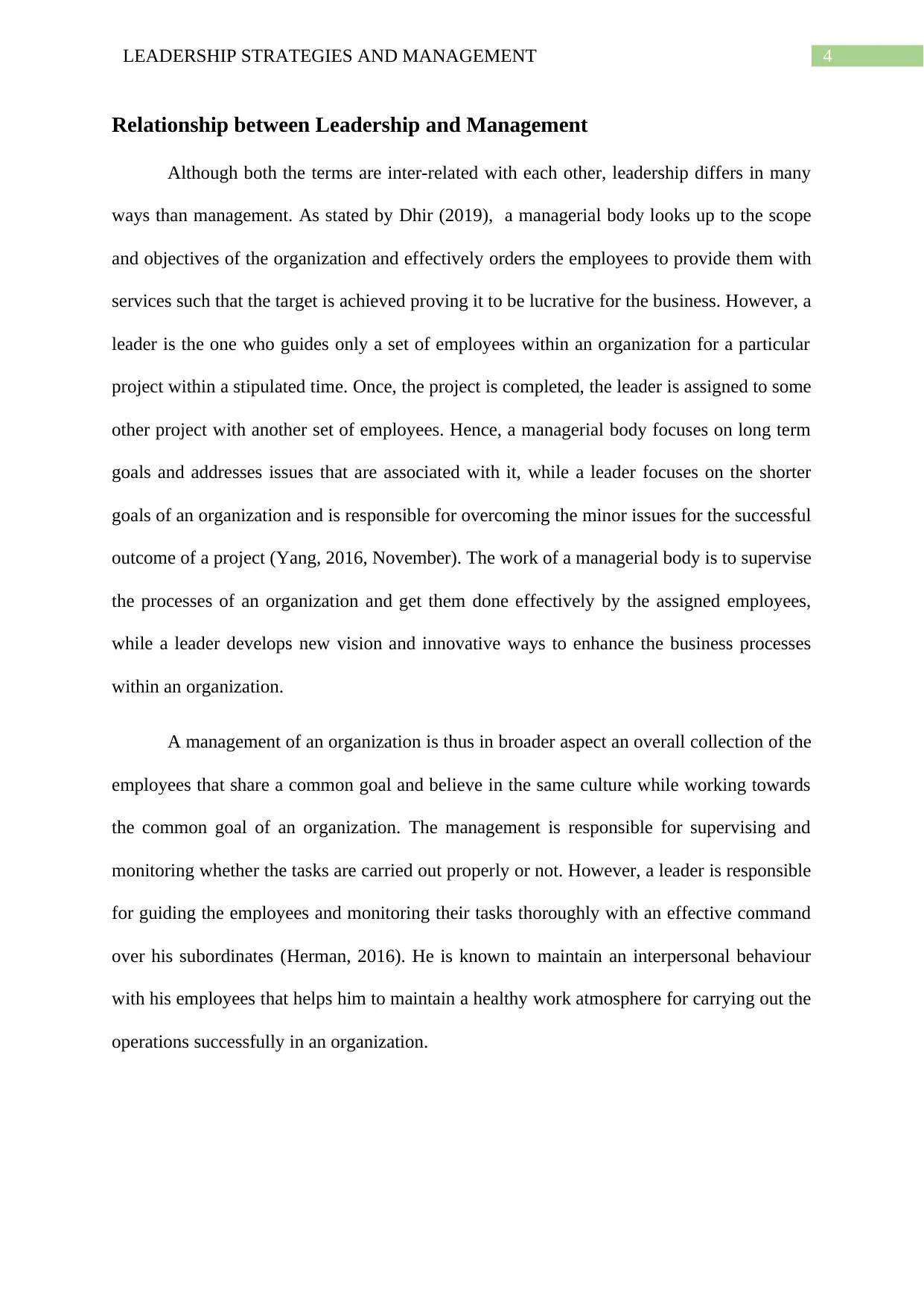
4LEADERSHIP STRATEGIES AND MANAGEMENT
Relationship between Leadership and Management
Although both the terms are inter-related with each other, leadership differs in many
ways than management. As stated by Dhir (2019), a managerial body looks up to the scope
and objectives of the organization and effectively orders the employees to provide them with
services such that the target is achieved proving it to be lucrative for the business. However, a
leader is the one who guides only a set of employees within an organization for a particular
project within a stipulated time. Once, the project is completed, the leader is assigned to some
other project with another set of employees. Hence, a managerial body focuses on long term
goals and addresses issues that are associated with it, while a leader focuses on the shorter
goals of an organization and is responsible for overcoming the minor issues for the successful
outcome of a project (Yang, 2016, November). The work of a managerial body is to supervise
the processes of an organization and get them done effectively by the assigned employees,
while a leader develops new vision and innovative ways to enhance the business processes
within an organization.
A management of an organization is thus in broader aspect an overall collection of the
employees that share a common goal and believe in the same culture while working towards
the common goal of an organization. The management is responsible for supervising and
monitoring whether the tasks are carried out properly or not. However, a leader is responsible
for guiding the employees and monitoring their tasks thoroughly with an effective command
over his subordinates (Herman, 2016). He is known to maintain an interpersonal behaviour
with his employees that helps him to maintain a healthy work atmosphere for carrying out the
operations successfully in an organization.
Relationship between Leadership and Management
Although both the terms are inter-related with each other, leadership differs in many
ways than management. As stated by Dhir (2019), a managerial body looks up to the scope
and objectives of the organization and effectively orders the employees to provide them with
services such that the target is achieved proving it to be lucrative for the business. However, a
leader is the one who guides only a set of employees within an organization for a particular
project within a stipulated time. Once, the project is completed, the leader is assigned to some
other project with another set of employees. Hence, a managerial body focuses on long term
goals and addresses issues that are associated with it, while a leader focuses on the shorter
goals of an organization and is responsible for overcoming the minor issues for the successful
outcome of a project (Yang, 2016, November). The work of a managerial body is to supervise
the processes of an organization and get them done effectively by the assigned employees,
while a leader develops new vision and innovative ways to enhance the business processes
within an organization.
A management of an organization is thus in broader aspect an overall collection of the
employees that share a common goal and believe in the same culture while working towards
the common goal of an organization. The management is responsible for supervising and
monitoring whether the tasks are carried out properly or not. However, a leader is responsible
for guiding the employees and monitoring their tasks thoroughly with an effective command
over his subordinates (Herman, 2016). He is known to maintain an interpersonal behaviour
with his employees that helps him to maintain a healthy work atmosphere for carrying out the
operations successfully in an organization.
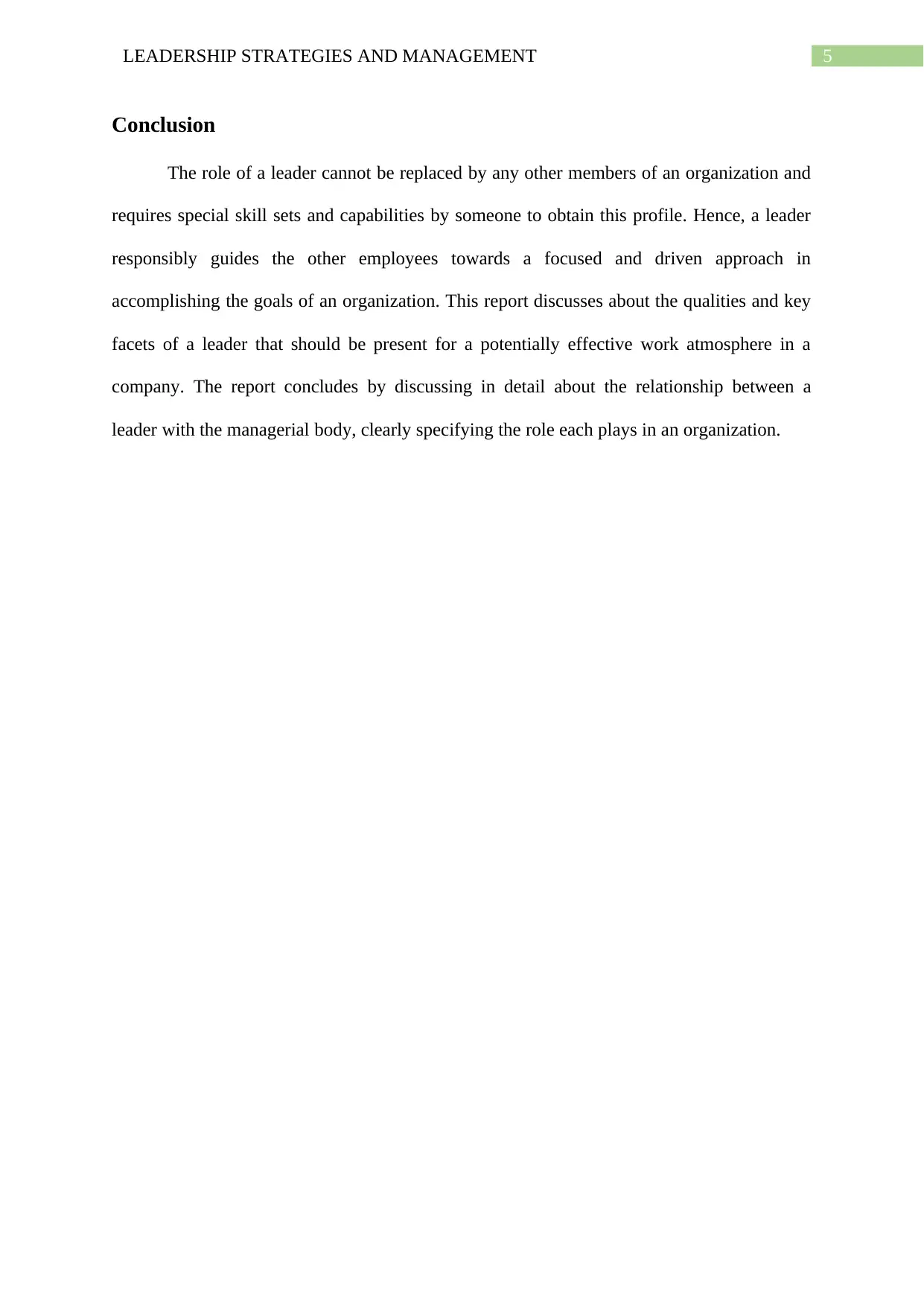
5LEADERSHIP STRATEGIES AND MANAGEMENT
Conclusion
The role of a leader cannot be replaced by any other members of an organization and
requires special skill sets and capabilities by someone to obtain this profile. Hence, a leader
responsibly guides the other employees towards a focused and driven approach in
accomplishing the goals of an organization. This report discusses about the qualities and key
facets of a leader that should be present for a potentially effective work atmosphere in a
company. The report concludes by discussing in detail about the relationship between a
leader with the managerial body, clearly specifying the role each plays in an organization.
Conclusion
The role of a leader cannot be replaced by any other members of an organization and
requires special skill sets and capabilities by someone to obtain this profile. Hence, a leader
responsibly guides the other employees towards a focused and driven approach in
accomplishing the goals of an organization. This report discusses about the qualities and key
facets of a leader that should be present for a potentially effective work atmosphere in a
company. The report concludes by discussing in detail about the relationship between a
leader with the managerial body, clearly specifying the role each plays in an organization.
⊘ This is a preview!⊘
Do you want full access?
Subscribe today to unlock all pages.

Trusted by 1+ million students worldwide
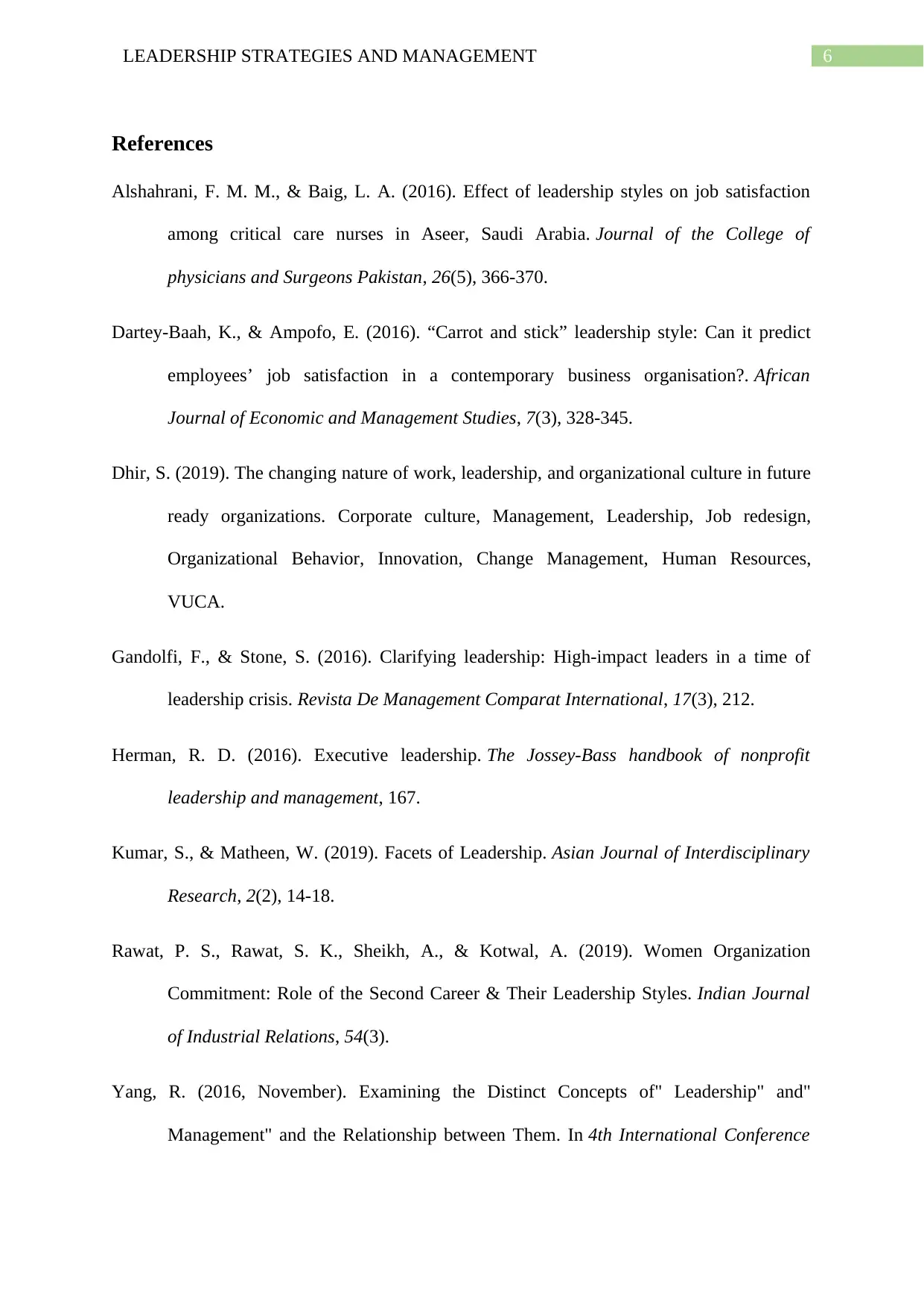
6LEADERSHIP STRATEGIES AND MANAGEMENT
References
Alshahrani, F. M. M., & Baig, L. A. (2016). Effect of leadership styles on job satisfaction
among critical care nurses in Aseer, Saudi Arabia. Journal of the College of
physicians and Surgeons Pakistan, 26(5), 366-370.
Dartey-Baah, K., & Ampofo, E. (2016). “Carrot and stick” leadership style: Can it predict
employees’ job satisfaction in a contemporary business organisation?. African
Journal of Economic and Management Studies, 7(3), 328-345.
Dhir, S. (2019). The changing nature of work, leadership, and organizational culture in future
ready organizations. Corporate culture, Management, Leadership, Job redesign,
Organizational Behavior, Innovation, Change Management, Human Resources,
VUCA.
Gandolfi, F., & Stone, S. (2016). Clarifying leadership: High-impact leaders in a time of
leadership crisis. Revista De Management Comparat International, 17(3), 212.
Herman, R. D. (2016). Executive leadership. The Jossey-Bass handbook of nonprofit
leadership and management, 167.
Kumar, S., & Matheen, W. (2019). Facets of Leadership. Asian Journal of Interdisciplinary
Research, 2(2), 14-18.
Rawat, P. S., Rawat, S. K., Sheikh, A., & Kotwal, A. (2019). Women Organization
Commitment: Role of the Second Career & Their Leadership Styles. Indian Journal
of Industrial Relations, 54(3).
Yang, R. (2016, November). Examining the Distinct Concepts of" Leadership" and"
Management" and the Relationship between Them. In 4th International Conference
References
Alshahrani, F. M. M., & Baig, L. A. (2016). Effect of leadership styles on job satisfaction
among critical care nurses in Aseer, Saudi Arabia. Journal of the College of
physicians and Surgeons Pakistan, 26(5), 366-370.
Dartey-Baah, K., & Ampofo, E. (2016). “Carrot and stick” leadership style: Can it predict
employees’ job satisfaction in a contemporary business organisation?. African
Journal of Economic and Management Studies, 7(3), 328-345.
Dhir, S. (2019). The changing nature of work, leadership, and organizational culture in future
ready organizations. Corporate culture, Management, Leadership, Job redesign,
Organizational Behavior, Innovation, Change Management, Human Resources,
VUCA.
Gandolfi, F., & Stone, S. (2016). Clarifying leadership: High-impact leaders in a time of
leadership crisis. Revista De Management Comparat International, 17(3), 212.
Herman, R. D. (2016). Executive leadership. The Jossey-Bass handbook of nonprofit
leadership and management, 167.
Kumar, S., & Matheen, W. (2019). Facets of Leadership. Asian Journal of Interdisciplinary
Research, 2(2), 14-18.
Rawat, P. S., Rawat, S. K., Sheikh, A., & Kotwal, A. (2019). Women Organization
Commitment: Role of the Second Career & Their Leadership Styles. Indian Journal
of Industrial Relations, 54(3).
Yang, R. (2016, November). Examining the Distinct Concepts of" Leadership" and"
Management" and the Relationship between Them. In 4th International Conference
Paraphrase This Document
Need a fresh take? Get an instant paraphrase of this document with our AI Paraphraser
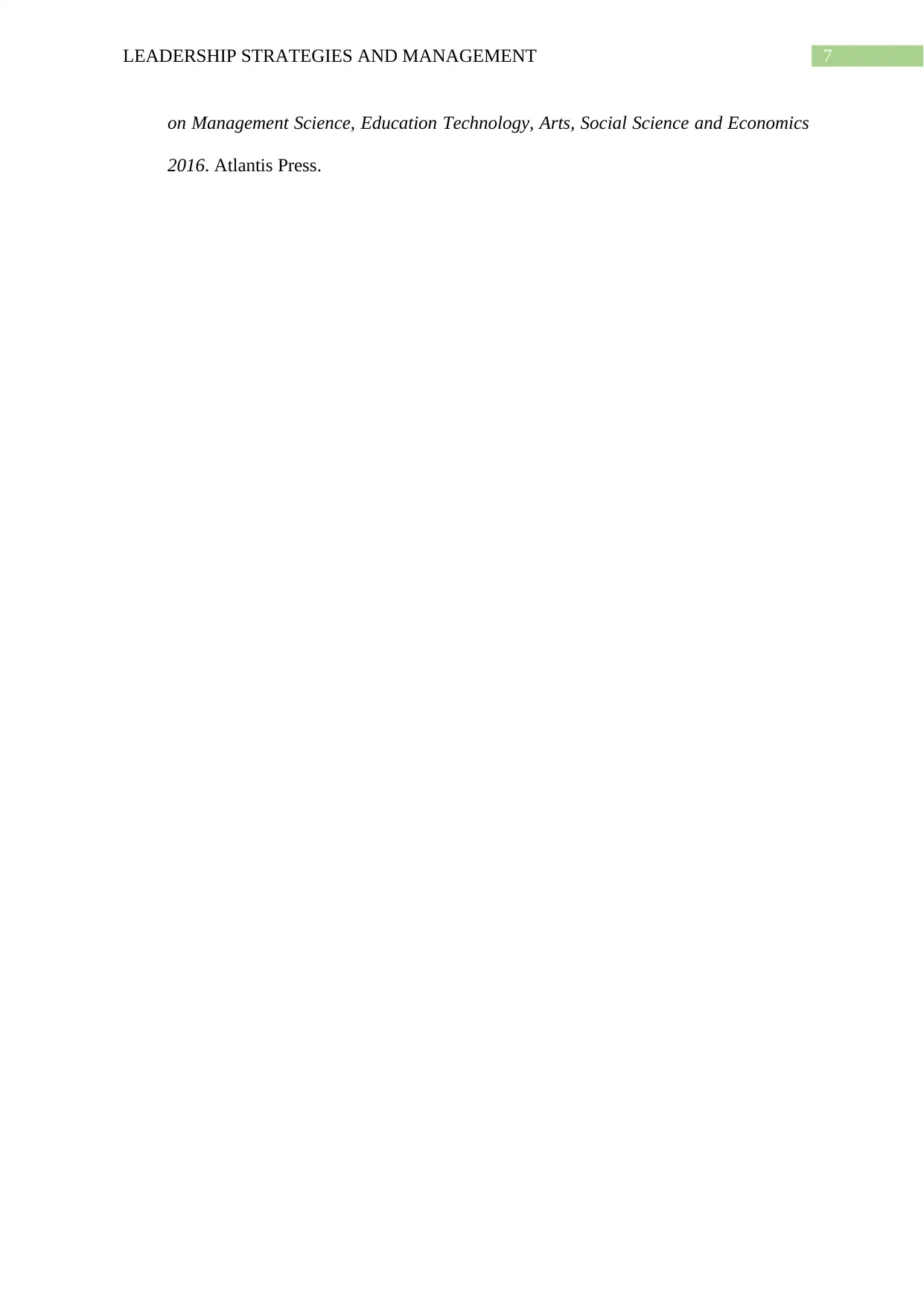
7LEADERSHIP STRATEGIES AND MANAGEMENT
on Management Science, Education Technology, Arts, Social Science and Economics
2016. Atlantis Press.
on Management Science, Education Technology, Arts, Social Science and Economics
2016. Atlantis Press.
1 out of 8
Related Documents
Your All-in-One AI-Powered Toolkit for Academic Success.
+13062052269
info@desklib.com
Available 24*7 on WhatsApp / Email
![[object Object]](/_next/static/media/star-bottom.7253800d.svg)
Unlock your academic potential
© 2024 | Zucol Services PVT LTD | All rights reserved.





